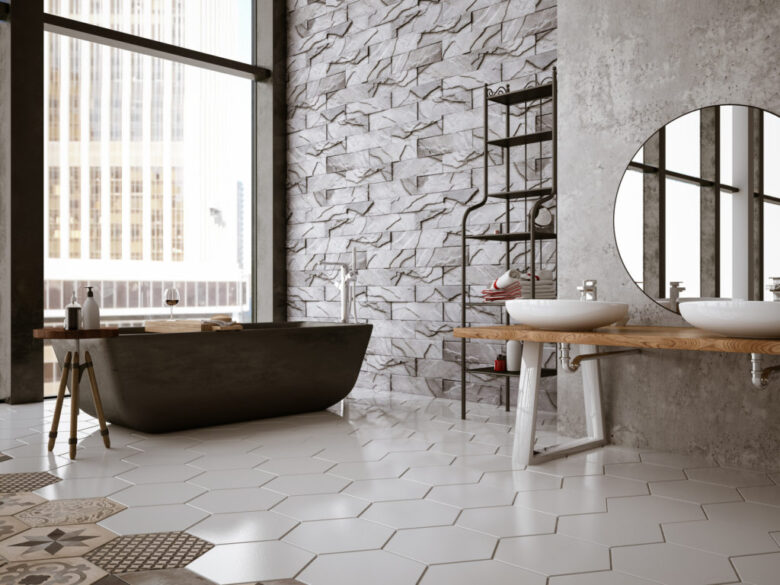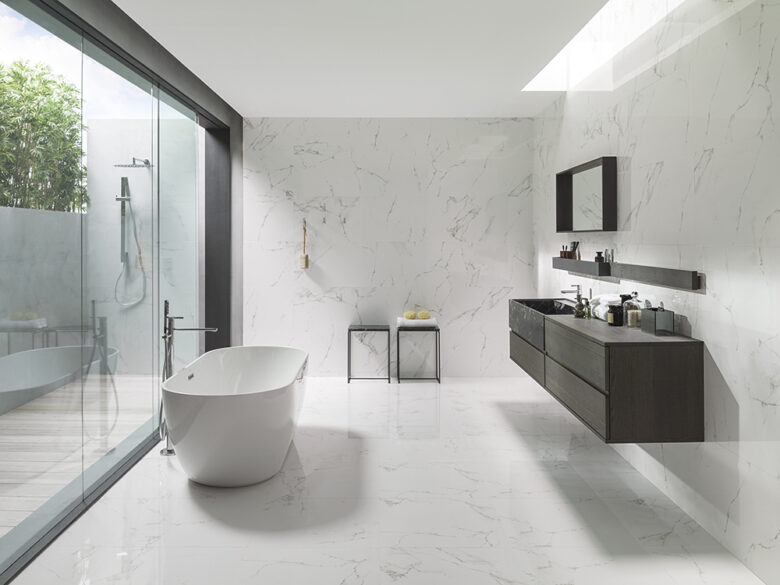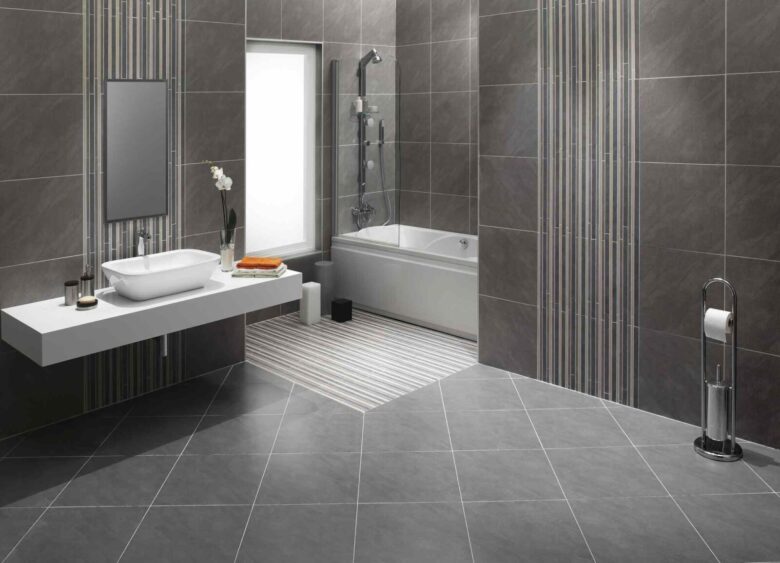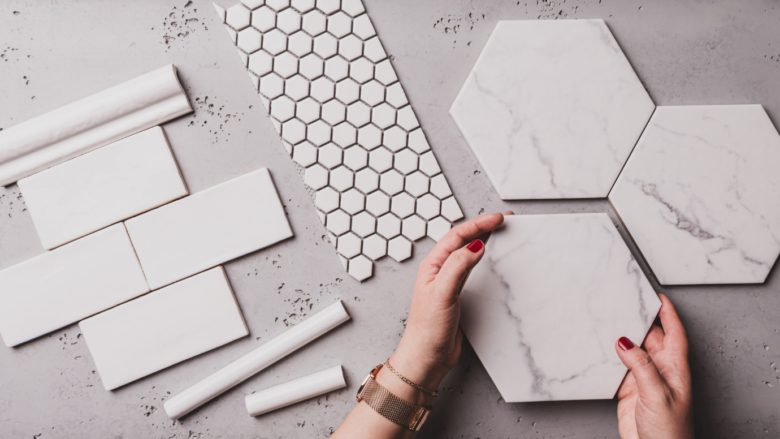If you’re having a new bathroom fitted, you’ve probably got an idea of what type of bath and shower you want.
But have you thought about the floor tiles?
The bathroom is one of the busiest corners of a home that has many boxes to tick – and, as the first thing you’ll notice when you walk in, floor tiles can make or break the look and feel of the room.
In this blog, we’ll guide you in choosing the perfect bathroom floor tiles and share tips on how to arrange them.
Bathroom tile materials

Ranging from natural stone to man-made tiles, deciding on the best type for your bathroom can be an overwhelming task.
However, if you live in a busy household or frequently have guests over to stay, it’s worth choosing durable tiles that won’t scratch or chip easily. After all, a damaged tile will become an eyesore and is vulnerable to further damage, especially in a room that’s prone to high levels of moisture and humidity.
To help narrow your options down, let’s take a closer look at some of the most durable options available:
-
Porcelain
Porcelain tiles are one of the strongest types of tile on the market. This dense material is highly resistant to scratches and chips, easy to maintain and waterproof – making it a brilliant choice for bathrooms and wet rooms.
-
Ceramic
Ceramic tiles are a more affordable alternative to porcelain tiles. They are equally as resistant to scratches and require minimal maintenance, but dropping heavy objects on them could result in chipping or cracks.
-
Vinyl
Vinyl tiles are considerably cheaper than porcelain and ceramic tiles but inherently resistant to scratches and stains (ideal if you use fake tan or hair dye in your bathroom!). Similarly to ceramic tiles, dragging sharp or heavy objects across vinyl surfaces is not recommended and may cause tearing.
Bathroom tile colours and finishes
The colour of your tiles can dictate the feel of a room – with bold, primary colours best suited to family bathrooms and muted shades being preferred in stylish en-suites and wet rooms.
Lighter colours can (and do) make a space feel much bigger than it is, but that’s not to say you shouldn’t introduce contrast with different colours and patterns to give your room a more interesting look.
When choosing tile colours, think carefully about your colour scheme and try to pick one or two accent colours to complement any bold hues and tie them in for a cohesive look.
Something else to consider when choosing floor tiles for your bathroom is your preferred finish. Gloss tiles are incredibly easy to clean and reflect light – making your room feel much brighter – whereas matt tiles don’t show watermarks as easily. These can also mimic materials to provide the natural appearance of stone, for instance, without the upkeep.
Bathroom tile patterns

Floor tiles might be slightly more hardwearing than wall tiles, but they needn’t be boring!
Floor tiles are remarkably versatile and you can experiment with mosaic patterns and different layouts.
For example, you could lay them in a square or grid pattern to create a clean, modern aesthetic – keeping distractions to a minimum. Or you could go for a diagonal pattern to make your cosy bathroom feel larger.
Another clean and classic option is the brick tile pattern, laying them in rows and shifting each row to create an offset pattern.
Though more complex in design, herringbone is a popular pattern for bathroom floors, too. It’s suitable for traditional and contemporary bathrooms alike and is often best used with neutral colour schemes and a contrasting grout colour.
Bathroom tile brands
When shopping for bathroom floor tiles, you’ll likely come across products from various brands (including some you may not have heard of before).
Although it largely depends on your budget and how much you can realistically afford to spend, you get what you pay for. So, if you have a little more spending room, it’s worth investing in top-quality floor tiles from a leading supplier, such as Craven Dunnil, Karndean or Utopia Bathrooms.
Choosing the right floor tiles for your bathroom is a crucial decision that can significantly impact the overall aesthetics, functionality, and maintenance of the space. With a plethora of options available in the market, ranging from materials and patterns to colors and sizes, it can be overwhelming to make the right choice. In this comprehensive guide, we will walk you through the key factors to consider when selecting bathroom floor tiles.
Material Matters:
The material of the floor tiles is a crucial consideration, as it determines the durability, water resistance, and overall appearance of your bathroom. Some popular options include:
- Ceramic Tiles: These are a cost-effective and durable choice, known for their resistance to water and stains. Ceramic tiles are available in a variety of colors and patterns, making them versatile for different bathroom styles.
- Porcelain Tiles: Similar to ceramic tiles but denser, porcelain tiles are highly durable and water-resistant. They come in a wide range of designs, including those that mimic natural stone or wood.
- Natural Stone Tiles: Options like marble, granite, and travertine add a luxurious and timeless feel to your bathroom. However, they require more maintenance and may be porous, so sealing is recommended.
- Vinyl Tiles: Affordable and available in various designs, vinyl tiles are water-resistant and comfortable underfoot. They are a practical choice for bathrooms with high moisture levels.
- Mosaic Tiles: These small tiles come in various materials and can be arranged to create intricate patterns. Mosaic tiles are an excellent choice for adding a unique and artistic touch to your bathroom floor.
Slip Resistance:
Given the water-prone nature of bathrooms, it’s crucial to prioritize slip resistance when choosing floor tiles. Look for tiles with textured surfaces or those labeled as slip-resistant to ensure safety, especially in areas prone to water splashes.
Size and Layout:

The size of the tiles and the layout pattern can influence the visual perception of your bathroom. Larger tiles can make a small space appear larger, while smaller tiles can add more visual interest. Consider the proportions of your bathroom and choose a tile size that complements the overall design.
Color and Style:
The color and style of your bathroom floor tiles play a significant role in the overall ambiance of the space. Light-colored tiles can make the room feel more spacious, while darker tiles can add warmth and coziness. Consider the existing color scheme of your bathroom and choose tiles that complement or contrast effectively.
Maintenance and Cleaning:
Different tile materials require varying levels of maintenance. Consider your lifestyle and the amount of time you are willing to invest in cleaning and upkeep. While natural stone may require periodic sealing, ceramic and porcelain tiles are generally easier to maintain.
Budget Considerations:

Establish a budget for your bathroom renovation and choose floor tiles that align with your financial constraints. Keep in mind that while certain materials may have a higher upfront cost, they can prove to be more cost-effective in the long run due to their durability.
Compatibility with Underfloor Heating:
If you’re considering underfloor heating in your bathroom, ensure that the chosen tiles are compatible with this heating system. Porcelain and ceramic tiles are excellent choices for such applications.
Long-Term Trends vs. Timeless Appeal:
Consider whether you want to follow current design trends or opt for a timeless look that will withstand the test of time. Classic and neutral tile choices can provide a versatile backdrop for changing accessories and décor.
In conclusion, choosing bathroom floor tiles involves a careful balance between aesthetics, functionality, and practicality. By considering the factors mentioned above, you can make an informed decision that not only enhances the visual appeal of your bathroom but also ensures longevity and ease of maintenance. Take your time exploring options, gathering samples, and consulting with professionals to create a bathroom floor that meets both your personal style and practical needs.
If you’re spoilt for choice and can’t decide which bathroom floor tiles to choose for your new bathroom, don’t hesitate to contact bathroom specialists.

